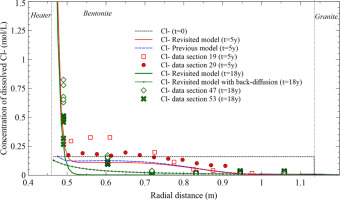当前位置:
X-MOL 学术
›
Appl. Clay. Sci.
›
论文详情
Our official English website, www.x-mol.net, welcomes your
feedback! (Note: you will need to create a separate account there.)
A revisited thermal, hydrodynamic, chemical and mechanical model of compacted bentonite for the entire duration of the FEBEX in situ test
Applied Clay Science ( IF 5.3 ) Pub Date : 2018-08-01 , DOI: 10.1016/j.clay.2018.02.019 Javier Samper , Alba Mon , Luis Montenegro
Applied Clay Science ( IF 5.3 ) Pub Date : 2018-08-01 , DOI: 10.1016/j.clay.2018.02.019 Javier Samper , Alba Mon , Luis Montenegro

|
Abstract The safety assessment of geological repositories for radioactive waste requires quantifying the geochemical evolution of the engineered clay barriers where thermal (T), hydrodynamic (H), mechanical (M) and chemical (C) phenomena play a major role during the early stages of the repository. Compacted bentonite is one of the components of the engineered barrier system. The FEBEX (Full-scale Engineered Barrier EXperiment) in situ heating and hydration test was performed at the Grimsel underground laboratory (Switzerland) in two operation periods. The 1st period lasted from 1997 to 2002 when heater 1 was switched off and the area around it was dismantled. Heater 2 was turned off and the full test was dismantled in 2015. Here we present a revisited THCM model of the two operation periods of the FEBEX in situ test, which improves the THCM model reported by Zheng et al. (2011) for the 1st operation period by revising the boundary condition at the heater/bentonite interface, refining the spatial discretization of the finite element mesh near the heater, updating the dispersivities of the bentonite and the granite and revisiting the back-diffusion of solutes from the bentonite barrier into the granite. The concentrations of dissolved Cl− computed with the revisited model at the end of the 1st operation period almost coincide with those of the previous model, except near the heater where the concentrations computed with the revisited model are much larger than those of the previous model. Both models provide a similar fit to the pore water concentration data inferred from aqueous extracts because the model differences occur in a band 0.045 m thick near the heater where there are no measured pore water chemical data. Solute back-diffusion from the bentonite pore water to the granite groundwater is not uniform along the FEBEX gallery due to the heterogeneity of the surrounding granitic formation. The revisited model reproduces the trends of the experimental observations of solute back-diffusion by adopting diffusion coefficients of the bentonite and granite larger than those of the simulation run without the solute back-diffusion. The results of the revisited THCM model match the gravimetric water content and dry density data measured at the end of both operation periods in 2002 and 2015 and fit the general trends of the on line data of temperature and volumetric water content in the bentonite and pore water pressure in the granitic rock collected from 2002 to 2015. The predicted concentrations of the dissolved species in 2002 are sensitive to changes in the vapour tortuosity factor and the retention curve of the bentonite, but are less sensitive to smectite dissolution. The predicted concentrations of the dissolved species at the end of the 2nd operation period in 2015 computed with the revisited THCM model are large near the heater and decrease towards the bentonite/granite interface. The concentrations are generally smaller than those computed at the end of the 1st operation period, except for the concentration of dissolved HCO3– which increases due to a calcite dissolution front. The predicted pH at the end of the 2nd operation period is similar to that of the 1st operation period. The concentrations of dissolved Cl− predicted at the end of the 2nd period with the revisited model reproduce the sharp increase of the measured Cl− data near the heater and match the data measured in 5 out of 6 radial distances.
中文翻译:

在 FEBEX 原位测试的整个持续时间内重新审视压实膨润土的热、流体动力学、化学和机械模型
摘要 放射性废物地质处置库的安全评估需要量化工程粘土屏障的地球化学演化,其中热 (T)、流体动力学 (H)、机械 (M) 和化学 (C) 现象在早期阶段起主要作用。存储库。压实膨润土是工程屏障系统的组成部分之一。FEBEX(全尺寸工程屏障实验)原位加热和水化试验在格里姆塞尔地下实验室(瑞士)进行了两个操作时期。第一个时期从 1997 年持续到 2002 年,当时关闭了加热器 1,并拆除了它周围的区域。2015年2号加热器关闭,全部测试拆除。 这里我们提出了FEBEX原位测试两个运行期的THCM模型,改进了Zheng等人报告的THCM模型。(2011) 对于第 1 个操作期,通过修改加热器/膨润土界面的边界条件,细化加热器附近有限元网格的空间离散化,更新膨润土和花岗岩的弥散度,并重新审视溶质的反向扩散从膨润土屏障进入花岗岩。在第一个操作期结束时,使用重新访问的模型计算的溶解 Cl− 浓度几乎与之前的模型一致,除了在加热器附近,使用重新访问的模型计算的浓度比之前的模型大得多。由于模型差异出现在带 0 中,因此两种模型都提供了与从水提取物推断出的孔隙水浓度数据相似的拟合。加热器附近 045 m 厚,没有测量的孔隙水化学数据。由于周围花岗岩地层的非均质性,溶质从膨润土孔隙水到花岗岩地下水的反向扩散沿着 FEBEX 廊道并不均匀。重新审视的模型通过采用比没有溶质反向扩散的模拟运行更大的膨润土和花岗岩的扩散系数来再现溶质反向扩散的实验观察结果。重新审视的 THCM 模型的结果与 2002 年和 2015 年两个运营期结束时测量的重量含水量和干密度数据相匹配,并拟合了膨润土和孔隙水中温度和体积含水量在线数据的总体趋势2002 年至 2015 年收集的花岗岩中的压力。2002 年溶解物质的预测浓度对蒸汽曲折系数和膨润土保留曲线的变化很敏感,但对蒙脱石溶解不太敏感。使用重新审视的 THCM 模型计算的 2015 年第二次运行期结束时溶解物种的预测浓度在加热器附近很大,并且朝着膨润土/花岗岩界面降低。除了溶解的 HCO3 浓度外,这些浓度通常比在第一个操作期结束时计算的要小,因为方解石溶解前沿会增加该浓度。第 2 次运行期末预测的 pH 值与第 1 次运行期相似。
更新日期:2018-08-01
中文翻译:

在 FEBEX 原位测试的整个持续时间内重新审视压实膨润土的热、流体动力学、化学和机械模型
摘要 放射性废物地质处置库的安全评估需要量化工程粘土屏障的地球化学演化,其中热 (T)、流体动力学 (H)、机械 (M) 和化学 (C) 现象在早期阶段起主要作用。存储库。压实膨润土是工程屏障系统的组成部分之一。FEBEX(全尺寸工程屏障实验)原位加热和水化试验在格里姆塞尔地下实验室(瑞士)进行了两个操作时期。第一个时期从 1997 年持续到 2002 年,当时关闭了加热器 1,并拆除了它周围的区域。2015年2号加热器关闭,全部测试拆除。 这里我们提出了FEBEX原位测试两个运行期的THCM模型,改进了Zheng等人报告的THCM模型。(2011) 对于第 1 个操作期,通过修改加热器/膨润土界面的边界条件,细化加热器附近有限元网格的空间离散化,更新膨润土和花岗岩的弥散度,并重新审视溶质的反向扩散从膨润土屏障进入花岗岩。在第一个操作期结束时,使用重新访问的模型计算的溶解 Cl− 浓度几乎与之前的模型一致,除了在加热器附近,使用重新访问的模型计算的浓度比之前的模型大得多。由于模型差异出现在带 0 中,因此两种模型都提供了与从水提取物推断出的孔隙水浓度数据相似的拟合。加热器附近 045 m 厚,没有测量的孔隙水化学数据。由于周围花岗岩地层的非均质性,溶质从膨润土孔隙水到花岗岩地下水的反向扩散沿着 FEBEX 廊道并不均匀。重新审视的模型通过采用比没有溶质反向扩散的模拟运行更大的膨润土和花岗岩的扩散系数来再现溶质反向扩散的实验观察结果。重新审视的 THCM 模型的结果与 2002 年和 2015 年两个运营期结束时测量的重量含水量和干密度数据相匹配,并拟合了膨润土和孔隙水中温度和体积含水量在线数据的总体趋势2002 年至 2015 年收集的花岗岩中的压力。2002 年溶解物质的预测浓度对蒸汽曲折系数和膨润土保留曲线的变化很敏感,但对蒙脱石溶解不太敏感。使用重新审视的 THCM 模型计算的 2015 年第二次运行期结束时溶解物种的预测浓度在加热器附近很大,并且朝着膨润土/花岗岩界面降低。除了溶解的 HCO3 浓度外,这些浓度通常比在第一个操作期结束时计算的要小,因为方解石溶解前沿会增加该浓度。第 2 次运行期末预测的 pH 值与第 1 次运行期相似。











































 京公网安备 11010802027423号
京公网安备 11010802027423号